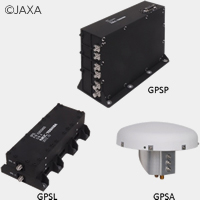Next Generation GPS Reciever

| Registration date (updated date) |
6/20/2014 (10/3/2014) |
|---|---|
| JAXA development group | Research Unit I, Research and Development Directorate |
| View diagram | See Attachment 1-1(GPSA) See Attachment 1-2(GPSL) See Attachment 1-3(GPSP) |
| Environmental resistance | See Attachment 2 |
| Patent number (publication number) |
N/A |
| Reference | N/A |
| Satellite and launch date | Flight models will be launched on ASTRO-H in FY2015 |
| Note | N/A |
Manufacturer
NEC Space Technologies, Ltd.
1-10, Nissin-cho, Fuchu, Tokyo, Japan
https://www.necspace.co.jp/en/index.html
Features
Next Generation GPS Reciever possesses three antenna inputs and 88-channel port which enables the reciever to output its position continously even under the condition that
spacecraft changes its attitude or orbit dynamically. The upgraded software and direct sampling apporach allowed the reciever to determine its position within the accuracy of 1.6 m 3 drms.
Compared with general spaceborne GPS reciever, this GPS reciever has advantage in its size, mass, and power consumption owing to the CMOS ASIC based RF frontend and Multi-chip module.
Applications
This GPS reciever is suitable for spacecrafts or satelites which require the precise orbit determination and orbit control.
Specifications
| Item | Specification | ||
|---|---|---|---|
| Configuration | GPSP (main package), GPSL (LNA), GPSA (antenna) |
||
| Number of antennas | Maximum of 3 antennas | ||
| Number of channels | L1C/A : 36 ch (Max) L2C (C/A) : 36 ch (Max) L2P (Y) : 16 ch (Max) |
||
| Types of signals | L1C/A, L2P (Y), L2C (C/A) | ||
| Size | GPSP : 96 × 218 × 155 (nom) GPSL : 74 × 158.5 × 45.5 (nom) GPSA : Φ 130 × 84 (nom) |
||
| Mass | GPSP : 1.95 kg GPSL : 0.54 kg/unit GPSA : 0.46 kg/unit |
||
| Power consumption | GPSR (Non-off mode) : 20.7 W GPSR (off mode) : 0.5 W |
||
| Signal power | L1C/A : -133.9 dBm to -112.0 dBm L2P (Y) : -138.7 dBm to 114.0 dBm L2C (C/A) : -135.2 dBm to -111.0 dBm |
||
|
Measurement accuracy (1σ) C/NO L1C/A : 46 dBHz L2P (Y) : 43 dBHz L2C (C/A) : 46 dBHz |
L1C/A pseudo-range |
<0.4 m | |
| L2P (Y) pseudo-range |
<1.1 m | ||
| L2C (C/A) pseudo-range |
<0.5 m | ||
| L1C/A delta-range |
<1.0 mm | ||
| L1C/A carrier-phase |
<0.7 mm | ||
| L2P (Y) carrier-phase |
<1.9 mm | ||
| L2C (C/A) carrier-phase |
<1.3 mm | ||
| Antenna coverage | L1 frequency | Minimum gain | >-4 dBi (within the off-boresight of 80 deg) |
| Maximum gain | <+8 dBi (within the off-boresight of 80 deg) |
||
| L2 frequency | Minimum gain | >-5 dBi (within the off-boresight of 75 deg) |
|
| Maximum gain | <+8 dBi (within the off-boresight of 75 deg) |
||
|
Direct navigation (Single frequency observation) |
Position rss | <2.3 m | |
| Velocity rss | <0.0078 m/s | ||
| Time | ±10 ns | ||
|
Direct navigation (Dual frequency observation) |
Position rss | <1.9 m | |
| Velocity rss | <0.0024 m | ||
| Time | ±10 ns | ||
|
Bias error calibrating navigation (Single frequency observation) |
Position rss | <2.1 m | |
| Velocity rss | <0.0059 m/s | ||
| Time | ±10 ns | ||
|
Bias error calibrating navigation (Dual frequency observation) |
Position rss | <1.6 m | |
| Velocity rss | <0.0082 m/s | ||
| Time | ±10 ns | ||
* navigation accuracy is evaluated on the basis of 3 Drms


